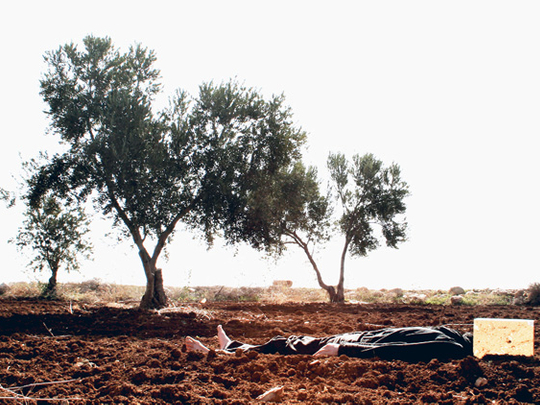
People living away from their homeland or moving around from one place to another is a reality in today's world. But whether a person is an immigrant by choice or forced to move because of circumstances, being uprooted leads to a fragmentation of the mind and a feeling of being out of place, with no sense of permanence. Perhaps nobody understands these feelings of displacement, alienation and transition better than the people of Palestine. Borderlines, Deconstructing Exile, an exhibition overseen by Berlin-based curator Charlotte Bank, brings together four contemporary Palestinian artists to help people take a closer look at identities and the idea of roots from a transcultural point of view.
Steve Sabella is based in Berlin; Larissa Sansour works in London and Amsterdam; Taysir Batniji lives in Paris; and Bashar Hroub has recently moved back to Ramallah from London. The four artists have drawn upon their personal experiences to explore the situations of an exile, a foreigner or a migrant, always trying to fit in and always forced to counter stereotypes and prejudices of the host societies. Despite the strong references to Palestinian issues, their work has a universal resonance. And it is especially relevant in an expatriate community such as the UAE.
Sabella expresses himself by using photography to deconstruct the familiar and create new realities that reflect his state of mind. His powerful composition, titled In Exile, depicts the façade of a building constructed from several haphazardly placed enclosed balconies.
The dark, disturbing image conveys a sense of disorientation, with the grills surrounding the balconies suggesting feelings of being imprisoned or excluded. "This work explores my own state of mind of living in a permanent ‘mental exile'. It is a visual expression of my sense of fragmentation, disorientation, confusion and dislocation," the artist says.
Batniji focuses on the transitory nature of the migrant experience, which places a person in a perpetual state of passing through, living in temporary conditions, forever expecting to pack and move on. His series of photographs, titled Chambres, features a set of seemingly abandoned rooms. But these stark rooms bear traces and memories of the various people who have occupied them at various times.
"I started this project during my residency at art school in France. As a student, I stayed at different lodgings, which got me interested in places of transit — spaces that draw a thin line between intimacy and detachment, disappearance and appearance. The rooms in these pictures are both personal and impersonal. Each space has its unique style and ambience, with objects chosen in a particular taste. Yet the rooms can accommodate different people without impacting or being impacted by the occupants. These spaces are neither a hotel nor an apartment. They are an oscillation between transitory and permanent places, abandoned and collected objects and absence and presence," Batniji says.
Hroub, on the other hand, is interested in the spaces of the mind. His series of photographs, titled Here and Now, deal with the personal vulnerability and the anxieties of migrants connected with issues such as religion, nationalism and identity.
The search within is symbolised by the presence of the artist in the pictures. But though you see his body, his face is always covered by mirrors that reflect the landscape around him, skilfully conveying the fear, the conflict, the longing for home and the desire to blend in, along with other feelings that fragment his mind. Hroub's ironical, faceless images appear to be cold and aloof but the strong emotions behind them can be gauged by the olive trees and vistas of an unattainable homeland that are reflected in the mirrors.
Sansour is not so subtle. Her project, titled A Space Exodus, consists of a video, photographs and an installation that present a whimsical, meticulously fabricated alternative reality. The video, which was recently nominated for the Muhr awards at the Dubai International Film Festival, shows the artist on a mission to land on the Moon. After initial problems, the mission is on course and viewers watch the young Palestinian woman "take one small step for a Palestinian, one giant leap for mankind". The artist triumphantly plants the Palestinian flag on the Moon but as she waves to the Earth, her country is not visible and remains a distant, impossible dream.
The film ends with the artist floating in space, calling out softly to Jerusalem. Four large photographs of the Palestinian Moon landing and 30 toy-like Palestinaut sculptures complete this fantasy world, which offers a naively optimistic vision for the future.
This is Green Art Gallery's last exhibition at its Jumeirah premises. "It is an emotional time, because we have been here for the past 16 years. But we are also excited about moving to our 3,000-square-foot premises in Al Quoz, because the area is fast developing into a vibrant art quarter and the new space gives us the opportunity to organise bigger and better exhibitions," says Yasmin Attasi gallery owner.
Jyoti Kalsi is a UAE-based arts enthusiast.
Borderlines, Deconstructing Exile will run at the Green Art gallery until November 30.











